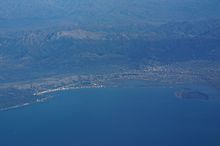Lezha district
| Circle : | Lezha |
| Main place: | Lezha |
| Qark : | Lezha district |
| Surface: | 473 km² |
| Residents: | 65,633 as of 2011 |
|
Population density: |
211.08 inhabitants / km² |
| ISO-3166-2 code: | ALL |
| License plate : | LE |
The district of Lezha ( Albanian : Rrethi i Lezhës ) was one of the 36 administrative districts of Albania that were abolished in the summer of 2015 after an administrative reform. It was named after the capital Lezha . The district in Lezha Qark with an area of 473 square kilometers had 65,633 inhabitants (2011 census). The local authorities gave a number of 99,843 inhabitants (2007). Around three quarters of the residents profess Catholicism .
Today the area forms the municipality of Lezha .
geography
The district of Lezha comprised an area in northwestern Albania on the coast of the Adriatic Sea and in the eastern foothills of the Mirdita and Skanderbeggebirge mountains . In the south the river Mat forms the border, in the north the river Drin defines the landscape. The east of the district is very hilly and partly very isolated. To the east of Lezha and in the very north-east, the hills in the Maja e Velës reach a height of 1171 m above sea level. A.
At Lezha, the hills almost reach the sea. Otherwise the coastal plain is several kilometers deep. From Lezha to the northwest, two long, narrow chains of hills run parallel along the Adriatic coast, each rising almost 400 meters from the plain. To the north of Lezha lies the fertile Zadrima plain, which extends to today's main arm of the Drin and thus almost to Shkodra . Its southern part to the villages of Blinisht and Fishta still belongs to Lezha County.
The small tributary of the river Drin ( Drini i Lezhës ) flows across the Zadrima from north to south , which at Lezha has created a passage between the northern Albanian mountains and the aforementioned range of hills by the sea. West of Lezha is the Kune-Vain wetland with the Drin estuary, numerous lagoons and swamps . This ecosystem is seriously endangered by humans, which has its causes in particular in the rural exodus , a lack of state power or corrupt authorities and the difficult economic conditions of the population.
economy
Like similar regions, the area around Lezha is suffering from the decline of communism , which has resulted in the loss of many jobs. There are still large industrial wastelands near Lezha, and the Gjadër military airfield in the Zadrima is largely closed. In the hilly hinterland in particular, almost any infrastructure is still missing - many villages are not connected to the road network, and many schools are in a desolate condition. It is different in the plain where many people have settled. The municipality of Shënkoll on the southwestern edge of the district had 13,102 people (2011 census), only slightly fewer inhabitants than the main town.
As a small regional center, Lezha ensures the supply of the region - for example with regular farmers' markets . The coastal plain around Lezha is also relatively well developed: The largely completed motorway to northern Albania, coming from Fushë-Kruja ( Tirana ), ends at the western entrance to the main town. Since 2005 it has continued from the northern exit to Shkodra. In addition, the district also has a small port with Shëngjin , the only one in northern Albania. In 2004, 293,300 tons of goods were handled there. In addition, the international route of the Albanian railway to Montenegro runs through Lezha.
Tourism in particular is of great economic importance in the region . Shëngjin beach attracts many Albanians from Kosovo and the surrounding areas in summer , since numerous hotels, holiday apartments and restaurants have been built here. It is quieter on Tale Beach . The historically significant sights of Lezha (grave of Skanderbeg , castle), on the other hand, cannot yet generate any significant income.
Communities
| Surname | Population (2011) | Community type |
|---|---|---|
| Lezha | 15,510 | Bashkia |
| Balldren | 6,142 | Komuna |
| Blinisht | 3,361 | Komuna |
| Dajç | 3.834 | Komuna |
| Kallmet | 4.118 | Komuna |
| Kolç | 4,228 | Komuna |
| Shëngjin | 8.091 | Komuna |
| Shënkoll | 13,102 | Komuna |
| Ungrej | 1,587 | Komuna |
| Zejmen | 5,660 | Komuna |
literature
- Gjin Biba: Transition de la collectivisation à la mini-exploitation paysanne en Albanie: analyze de la structure, du fonctionnement et des comportements des agriculteurs dans le district de Lezha . Montpellier 1998.
Individual evidence
- ↑ a b c Ines Nurja: Censusi i popullsisë dhe banesave / Population and Housing Census - Lezhë 2011 . Results Kryesore / Main Results. Ed .: INSTAT . Pjesa / Part 1. Adel Print, Tirana 2013 ( instat.gov.al [PDF; accessed April 14, 2019]).
- ↑ Rrethi Lezhë. In: Këshilli i Qarku Lezhë. Archived from the original on August 5, 2012 ; Retrieved January 13, 2009 .




